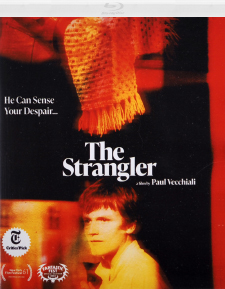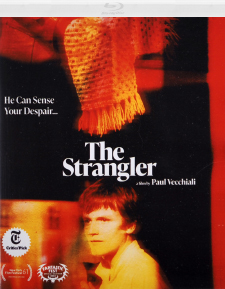Strangler, The (1970) (Blu-ray Review)

Director
Paul VecchialiRelease Date(s)
1970 (February 27, 2024)Studio(s)
Unité Trois/Reggane Films/Marianne Productions (Altered Innocence/Vinegar Syndrome)- Film/Program Grade: C-
- Video Grade: A
- Audio Grade: A
- Extras Grade: B
Review
So obscure there’s not even a Wikipedia entry for it, The Strangler (L’étrangleur, 1970) is described as a French giallo, which would seem a contradiction of terms. Giallo are films primarily Italian in origin and, in any case, The Strangler has little in common with those often-clever little films, other than its premise and 1970s trappings.
Rather, this is a self-consciously arty, often pretentious genre film seemingly made by hands totally unfamiliar with the mechanics of thrillers. On one hand it aspires to rise above its routine serial killer story in the manner of Michael Powell’s brilliant Peeping Tom (1960) but lacks the talent for the film even to work as an offbeat genre title. One huge problem is its gaping lapses in storytelling logic.
The picture stars Jacques Perrin, the dreamy-eyed young sailor from The Young Girls of Rochefort and later the adult Salvatore in Cinema Paradiso, as Émile, an open-air vegetable market worker (like the Covent Garden setting of Hitchcock’s Frenzy) who strangles lonely, depressed women in what he’s convinced himself are mercy killings. Police Inspector Simon Dangret (Julien Guiomar) appears on television to discuss the crime—for no clear reason—which, in turn, also with no clear reason, prompts Anna (Eva Simonet, Perrin’s real-life sister) to aggressively meddle in the affair, she obsessed with Émile and hoping to use herself as Dangret’s bait to bring him closer to her.
The one novel aspect of The Strangler is that, at the beginning of the story, a thief, billed in the credits as “The Jackal” (Paul Barge), witnesses one of Émile murders, and decides to follow behind him to rob Émile’s victims. For his part, Émile becomes quite upset when newspapers begin reporting that the victims are robbed as well as murdered, prompting him to regularly contact Dangret, truthfully asserting that he’s stolen from no one.
Unfortunately, much of the picture makes no sense. The many, even daily killings are the talk of France, yet Dangret seems to be the only detective working the case, hardly believable. In one scene Dangret wakes up in the middle of the night to discover that Émile has been in his room, watching him sleep. He leaves a note made from cut-out letters stating this (How did he know ahead of time?) and informing the flatfoot he’s just murdered his latest victim. What does Dangret do with this vital piece of evidence? He immediately crumples it up and tosses it in the trash! Later, Émile sets up a meeting with Dangret, during which Émile admits to the murders and Dangret questions his motives. Then, Émile casually tells the policeman that, well, he’d better be going. Dangret advises Émile against killing any more women, and lets the serial killer walk away. Huh? Clearly, Dangret is no Maigret; he’s an Inspector Clouseau without the laughs.
The plot becomes even more ridiculous in its final reels. The Jackal rides Émile’s ass for the entire story, popping up moments after every murder to rob the victims, but even after Dangret lets Émile slip through his fingers, he doesn’t even bother to tail him, allowing yet more murders and criminal negligence on the detective’s part. The resolution, which I won’t spoil for masochistic viewers, borders on nonsensical.
The film is awash in pretentiousness, with pointless cutaways to flashbacks and/or imaginings by Émile, psychobabble abstractions of street mayhem—stabbings, a gang rape (which its victim seems to enjoy), etc., Émile also haunted, or something, by the ghosts of the women he’s killed. Near the beginning is a nightclub scene some reviewers found imaginative but, to me, its carefully choreographed extras suggest a 1970s beer commercial, hardly great art.
The three leads try their best. Visually striking Eva Simonet was more active as a publicist than as an actress, but she holds the viewer’s interest. Julien Guiomar is like a French Aldo Ray. The musical score by Roland Vincent is interesting. Perhaps most tellingly, while the film premiered at the Cannes Film Festival in May 1970, it didn’t find a distributor for more than two years, the picture finally released in France in late 1972.
Altered Innocence’s Blu-ray is Region-Free and presents the film in its original 1.66:1 aspect ratio. The transfer is flawless, with excellent color and contrast, and no signs of damage at all. The French DTS-HD Master Audio (mono) is also excellent and both English and Spanish subtitles are offered.
Other than a newly-created trailer for revival screenings, the lone extra is Lost Boys and Sad Girls, a video essay by Alexandra-Heller Nicholas. She liked the film a lot more than I did, but makes a compelling case for it in this well-researched, useful supplement.
The Strangler certainly looks nice, both in its original cinematography and Altered Innocence’s new video transfer, but I found the film progressively absurd and, by the end, quite annoying in its clumsy storytelling.
- Stuart Galbraith IV

